
Transport in Norway is highly influenced by Norway's low population density, narrow shape and long coastline. Norway has old water transport traditions, but road, rail and air transport have increased in importance during the 20th century. Due to the low population density, public transport is somewhat less built out in rural areas of Norway, however public transport in, and around cities is well developed.

The Triangle Link is a fixed link with three branches connecting the islands of Stord and Bømlo to each other and the mainland at Sveio, Norway. It consists of the underwater Bømlafjord Tunnel from Sveio to the island of Føyno, the Stord Bridge from there to Stord, and a road including the Bømla Bridge and the Spissøy Bridge to Bømlo. The section from Sveio to Stord is part of European Route E39, while the branch to Bømlo is part of County Road 542.

The Nordhordland Bridge is a combined cable-stayed and pontoon bridge which crosses Salhusfjorden between Klauvaneset and the island of Flatøy in Vestland county, Norway. It is 1,614 meters (5,295 ft) long, of which the pontoon section is 1,246 meters (4,088 ft) long. The cable-stayed section consists of a single 99-meter (325 ft) tall H-pylon which has a length of 368 meters (1,207 ft) and a main span of 172 meters (564 ft). This allows for a clearance of 32 meters (105 ft).

The Stord Bridge is a suspension bridge which crosses Digernessundet between the islands of Stord and Føyno in Stord Municipality in Vestland county, Norway. The bridge is 1,077 meters (3,533 ft) long, has a main span of 677 meters (2,221 ft) and a clearance below of 18 meters (59 ft). It carries two lanes of European Route E39 and a combined pedestrian and bicycle pathway. It is part of the Triangle Link, a fixed link which connects Stord to Bømlo, and both to the mainland. In 2010, the bridge had an average 5,021 vehicles per day. The bridge and the link was a toll road from the opening until 30 May 2013.
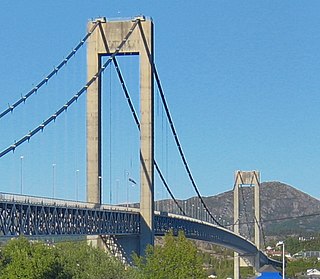
The Sotra Bridge is a suspension bridge which crosses Knarreviksundet between Knarrevik in Øygarden Municipality and Drotningsvik on the mainland of Bergen Municipality in Vestland county, Norway. It carries two road lanes and two narrow pedestrian paths of National Road 555, providing a fixed link for the archipelago of Sotra. The bridge is 1,236 metres (4,055 ft) long, has a main span of 468 metres (1,535 ft) and a clearance of 50 metres (160 ft). In 2007, it had an average 25,494 vehicles per day.

European route E39 is the designation of a 1,330 kilometres (830 mi) north–south road in Norway and Denmark from Klett, just south of Trondheim, to Aalborg via Bergen, Stavanger and Kristiansand. In total, there are nine ferries, more than any other single road in Europe.
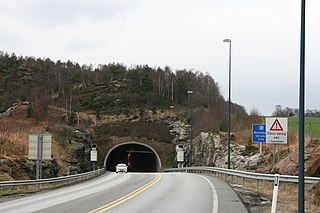
The Bømlafjord Tunnel is a subsea road tunnel under Bømlafjorden which connects the island of Føyno in Stord Municipality to the mainland at Dalshovda in Sveio Municipality in Vestland county, Norway. The tunnel is 7.82 kilometers (4.86 mi) long and reaches 260.4 m (854 ft) below mean sea level. It carries three lanes of European Road E39 and is part of the Triangle Link, a fixed link which connects Sunnhordland to Haugaland. Plans for the tunnel arose in the 1980s; construction started in 1997 and the tunnel opened on 27 December 2000. The tunnel was built using the drilling and blasting method, with two teams building from each end. The tunnel runs through an area composed mostly of gneiss, phyllite and greenstone. The tunnel was the longest subsea tunnel in Norway until the opening of Karmøytunnelen. It is still (2013) the deepest point on the E-road network. The tunnel was a toll road from the opening until 30 April 2013. In 2012 the tunnel had an average 4,084 vehicles per day.
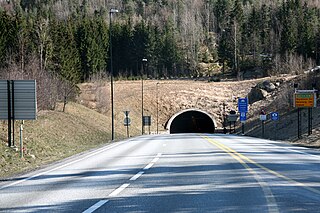
The Oslofjord Tunnel is a subsea road tunnel which traverses the Oslofjord, connecting Hurum and Frogn in Norway. Carrying three lanes, the 7,306-meter (23,970 ft) long tunnel reaches a depth of 134 meters (440 ft) below mean sea level. The tunnel has a maximum gradient of seven percent. It acts as a link connecting eastern and western Akershus county, supplementing the Moss–Horten Ferry which runs further south. The tunnel is since 2018 a part of European route E134, until 2018 it was part of National Road 23.
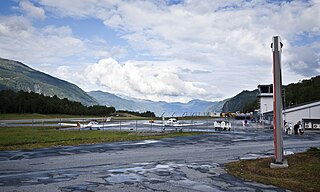
Sandane Airport is a regional airport serving the village of Sandane in Vestland county, Norway. It perpendicularly straddles the Anda peninsula in Gloppen Municipality between the Nordfjorden and Gloppefjorden. The airport has an asphalt runway measuring 970 by 30 meters and aligned 08/26. Services are provided by Widerøe on public service obligation with the Ministry of Transport and Communications. The airport is owned and operated by the state-owned Avinor and served 37,272 passengers in 2013.

Ryfast is a subsea tunnel system in Rogaland county, Norway. The tunnel system is part of the Norwegian National Road 13, and it runs between the city of Stavanger in Stavanger Municipality, under a large fjord, and the area of Solbakk in the municipality of Strand.

The Fannefjord Tunnel is a 2,743-meter (8,999 ft) long subsea road tunnel in Molde Municipality in Møre og Romsdal county, Norway. The tunnel is part of County Road 64 and it goes under the Fannefjorden, connecting the island of Bolsøya to the mainland at Årø, where it intersects with the European route E39 highway. The tunnel reaches a depth of −101 metres (−331 ft) in elevation with a maximum 10% grade.

The Langfjord Tunnel is a proposed subsea road tunnel which would cross Langfjorden between Molde and Rauma in Norway. It may also be built with a branch to the island of Sekken. As part of County Road 64, the tunnel would replace the Åfarnes–Sølsnes Ferry, and allow Romsdal ferry-free access to Eastern Norway, as well as connect Molde and Rauma. If the branch is built, it would replace the Molde–Sekken Ferry, giving the island a fixed link. The main tunnel would be between 10 and 11 kilometers long, which the branch would be slightly shorter than 5 kilometers (3.1 mi) long. The tunnel would reach 330 meters (1,080 ft) below mean sea level, making it the deepest subsea tunnel in the world. It would also be the longest subsea tunnel in Norway.
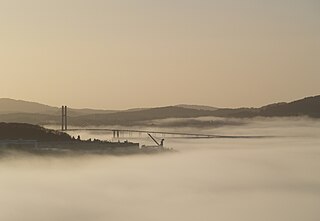
Salhusfjorden is a 4-kilometer (2.5 mi) long fjord and sound between Bergen Municipality and Alver Municipality in Vestland county, Norway. To the west, it starts between the villages of Salhus and Frekhaug, where the Byfjorden meets the Herdlefjorden. To the east, the fjord ends between the village of Knarvik and the Hordvikneset peninsula, where the Osterfjorden runs northeast, the Sørfjorden runs southeast, and the Radfjorden runs north. The fjord is up to 500 meters (1,600 ft) deep. It acts as one of the borders between the districts of Midhordland to the south and Nordhordland to the north. The islands of Holsnøy and Flatøy lie along the northern side of the fjord.
The Storfjord Bridge is a proposed suspension bridge that would span Storfjorden in Sunnmøre, Norway. If built, it would be 3,600 metres (11,800 ft) long and have a main span of 2,300 metres (7,500 ft). This would make it the longest spanned bridge in the world, easily surpassing the 1915 Çanakkale Bridge, which has a main span of 2,023 metres (6,637 ft). The plans have been developed by Aas-Jakobsen for a Storfjordsambandet, a company which aims to toll finance the bridge. According to Rolf M. Larssen of Aas-Jakobsen, there is a larger challenge securing sufficient funding than technically building the bridge. It is estimated to cost 4.3 billion Norwegian krone.

The Byfjord Tunnel is a subsea road tunnel in Rogaland county, Norway. The 5,875-metre-long (19,275 ft) tunnel runs between the village of Grødem on the mainland in Randaberg municipality and the island of Sokn in Stavanger municipality, running underneath the Byfjorden. The tunnel was built as part of the Rennesøy Fixed Link project which opened in 1992 with the goal of connecting all the islands of Rennesøy to the mainland. The tunnel was a toll road from 1992 until 2006. The tunnel is part of European route E39 highway. With a maximum 8% grade, the tunnel reaches a depth of 223 metres (732 ft) below sea level at its lowest point. The tunnel was Europe's longest and the world's deepest tunnel upon its completion, it was surpassed by a deeper tunnel in 1994 and a longer tunnel in 1999. The tunnel had an average daily traffic of 9,717 vehicles in 2018.
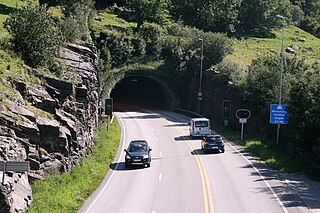
The Mastrafjord Tunnel is a subsea road tunnel in Stavanger municipality in Rogaland county, Norway. The 4,424-metre (2.75 mi) long tunnel runs under the Mastrafjorden, which flows between the islands of Mosterøy and Rennesøy. The tunnel opened in 1992 as part of the European route E39 highway and the Rennesøy Fixed Link. The southern end of the tunnel is located near the village of Askje on Mosterøy and the northern end of the tunnel is in the village of Vikevåg on Rennesøy. With a maximum grade of 8%, the tunnel reaches its deepest point at 133 metres (436 ft) below sea level.
The Bjarkøy Fixed Link is a fixed link which connects the three islands of Bjarkøya, Sandsøya, and Grytøya in Harstad Municipality in Troms county, Norway. The fixed link was completed in late 2018. A subsea road tunnel connects the islands of Grytøya and Bjarkøya, and a bridge connects the islands of Grytøya and Sandsøya. The tunnel to Bjarkøya is 3.25 kilometres (2.02 mi) long. The bridge to Grytøya is 300 metres (980 ft) long plus a 900-metre (3,000 ft) long causeway. The project also included 3 kilometres (1.9 mi) of new road on Grytøya to connect the existing roads to the new undersea tunnel. The Bjarkøy Tunnel is designated as part of Norwegian County Road 867, while the Sandsøya Bridge is part of Norwegian County Road 124.
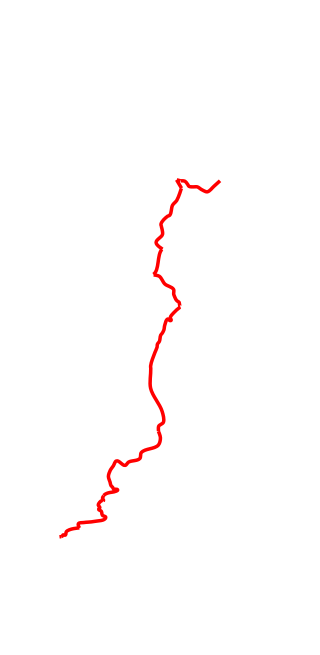
National Road 13 is a national road which runs from the town of Stavanger in Rogaland county to the village of Sogndalsfjøra in Vestland county. The route is 449.9 kilometers (279.6 mi) long and runs south–north through Rogaland and Vestland counties, following a more inland path than the European route E39 highway.

National Road 23, also known as the Oslofjord Link, was the name of a 40.2 kilometers (25.0 mi) largely limited-access road which connects the municipalities of Lier, Røyken, Hurum and Frogn in Norway. The 7.2-kilometer (4.5 mi) Oslofjord Tunnel causes the road to acts as the only fixed link crossing of the Oslofjord and makes that section subject to tolls. In 2018 the road was renamed into European route E134.

The Ryfylke Tunnel is an undersea road tunnel in Rogaland county, Norway. It is part of the Norwegian National Road 13 running between Stavanger and Ryfylke (district) under the Horgefjord. The tunnel is part of the Ryfast project. It is 14.4 kilometres (8.9 mi) long and is currently the world's longest subsea road tunnel, and the deepest tunnel of any kind. Both records are expected to be surpassed by Rogfast, which is projected to open in 2033.

















